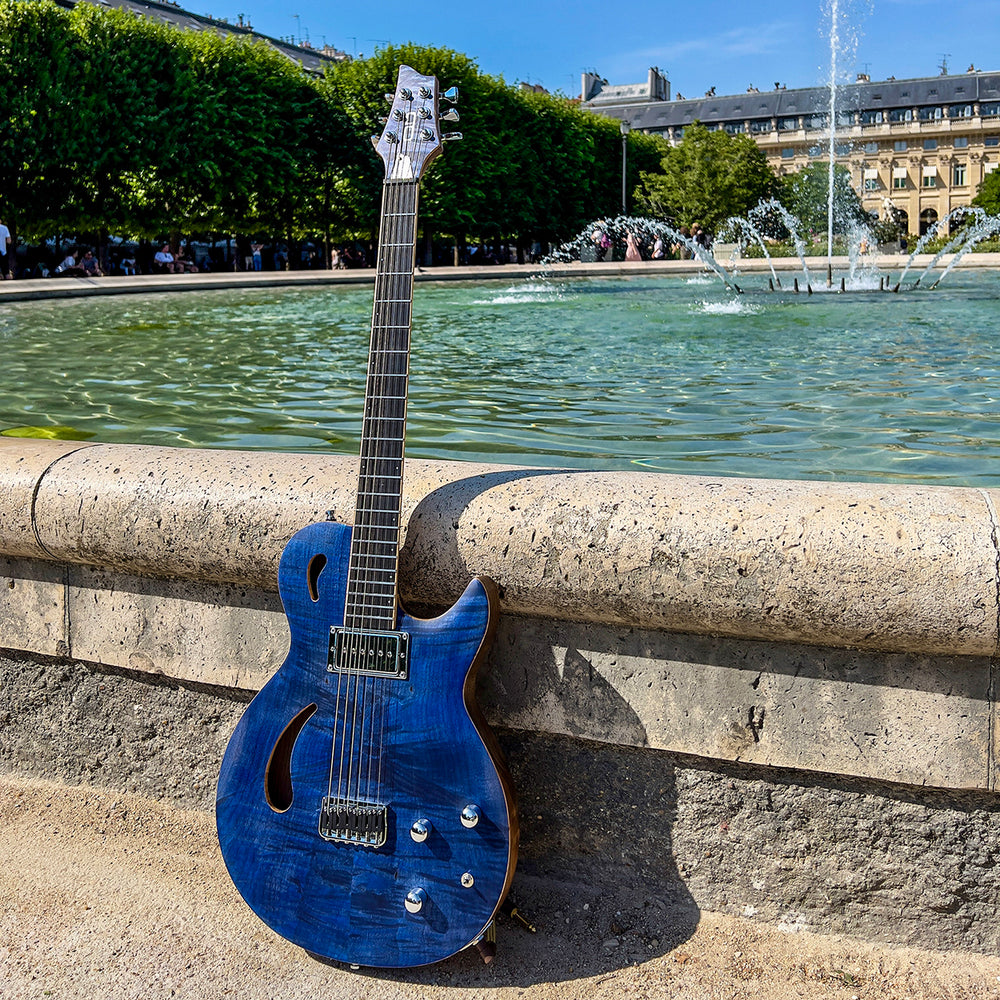TECHNICAL AND AESTHETIC CHOICES
OBJECTIVE: REVISIT THE "SG", WITHOUT COPYING IT, BY INTEGRATING MY ADDITIONAL TRICKS.
"WHY THIS SHAPE? "
For me, this is both rock and classic, modern yet traditional.
As a good "double cut" model (notches on each side of the neck), we benefit from a very "long" neck and with good access to the highs.
The guitar would be wood color, oiled finish.
Its beauty would therefore come from the quality of the wood chosen.
"THE ROUND"
The idea was to have a through neck, and not glued or screwed.
Why: The handle is made of a block that goes from the top of the head to the bottom of the body. It really integrates with the rest of the instrument. No heel and therefore, fabulous accessibility, right to the end.
The nut:
I chose a brass nut for the following reasons:
- I find it beautiful and it will age 
- Brass brings precision and brilliance (to enhance selected woods ... as you will see later)
In the end:
Neck with 24 frets, one piece of wood, with a brass nut. A handle that should be thin, but not too 
"THE WOODS"
I wanted dense woods. This is still linked to my obsession with keeping the note.
I also wanted “warm” woods. Having a SG, and a Godin, mahogany seemed like a good choice.
That's when Quentin offered me other woods that I hadn't thought of.
Amaranth is a wood which "oxidizes" in the air, after cutting, and which naturally becomes purple / violet (depending on the state of its tan. In addition, it is very dense ).
That's it, I was in love!
I had found the wood for the table (top of the guitar).
We now had to find a wood for the body and the neck. It wasn't long.
Exit the mahogany, hello walnut. It is a dense and warm wood, which can stand out with superb grain. Its basic gray tones would tend towards a gray / yellow when oiled. It was perfect.
Quentin was going to look for very "figurative", "very drawn" woods, it needed a "more sober" touch (the fingerboard being the top of the neck) to go with the set. We didn't look far. It would be ebony.
The ebony will also bring precision to the note and softness under the fingers.
The assembly would be in an oiled finish. No varnish. No painting. I will only have wood under my fingers. The guitar will breathe. The wood will age naturally.
"LUGGAGE"
The hardware is all the equipment that attaches to the guitar. The mechanics, the nut, the buttons, etc. This is an integral part of the final look.
I went with a smoky chrome complexion.
Quentin having a predilection for Schaller equipment, aesthetics and reliability would be there.
Locking tuners, pickup covers and the rest will be one color
One color, not really 
The nut logo on the head, my logo on the body and the backplates would be brass. Just a bit of “golden but not too much” shine.
"THE MICROS"
My choice fell on a hand-wound set from Dreamsongs Pickups associated with a piezo pickup in the bridge.
The neck pickup is P-90 which combines precision, snap, dynamics and warmth. (I have to admit, it quickly became my favorite mic).
The bridge pickup is a "PAF Classic 57 overwound" in order to have a wider range of sound. (Overwound to be balanced with the output level of the P90).
The Piezo pickup is there to bring the sound of an electro-acoustic guitar.
The choices are made. All that remains is to find the wood and order the gear.
Easy?
Not that much ... There are so many beautiful woods 
Once again, choosing the right elements with your luthier is an essential step. Take the time to do this. This is your guitar and it will only look better.
![]()









![[NEWS] Partenariat entre Miraval Studios et De Leeuw Guitars](http://www.deleeuw-guitars.fr/cdn/shop/articles/De_Leeuw_Guitars_Partnerariat_Miraval_Studios_-_Luthier_Francais_-_Namm_2024_-_Namm_show_-_David_Schwarz_-_Quentin_de_Leeuw_Partnership_-_Damien_Quintard_-_Brad_PItt.jpg?v=1703879232&width=1080)
Leave a comment